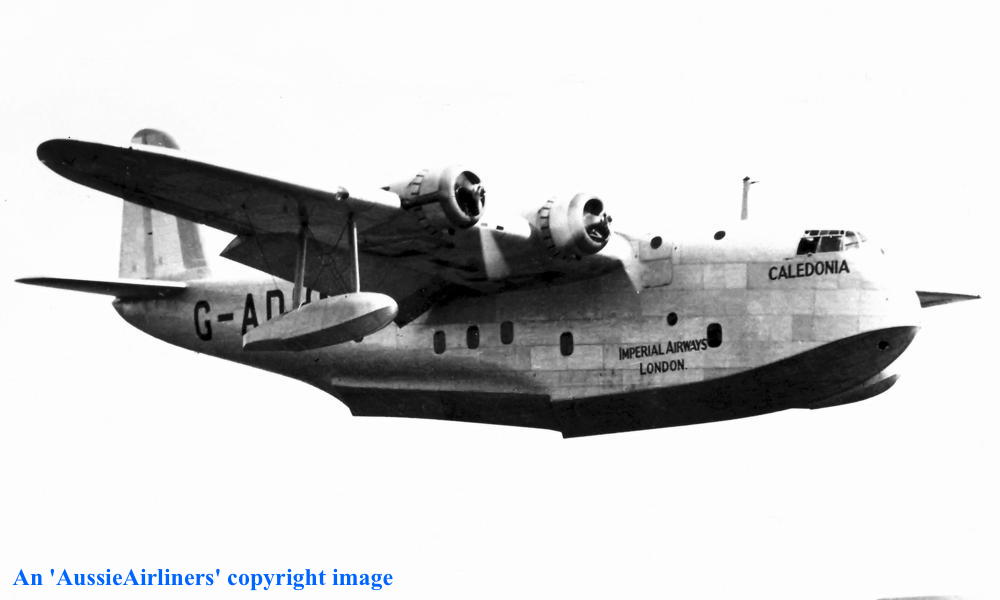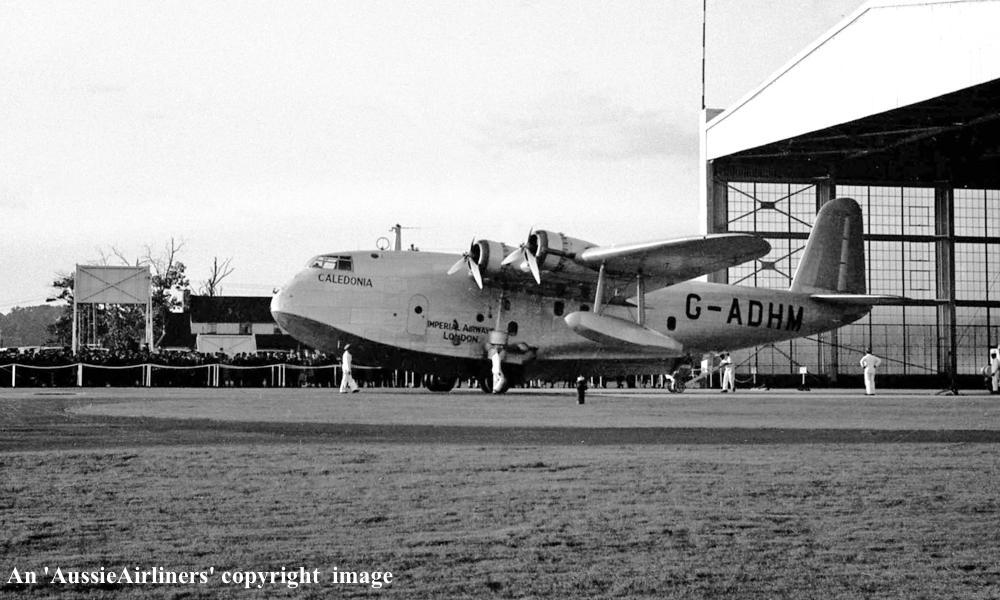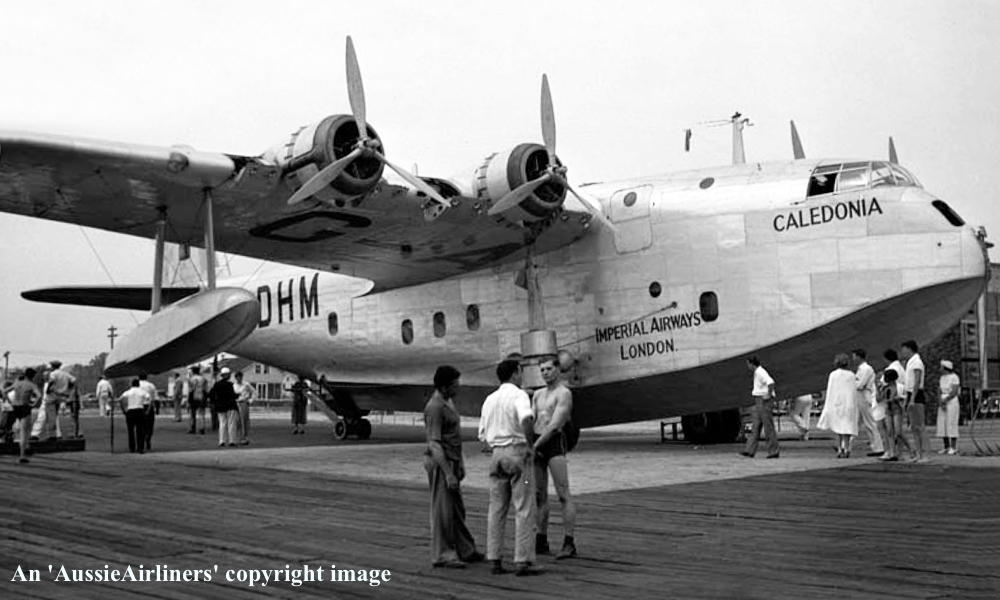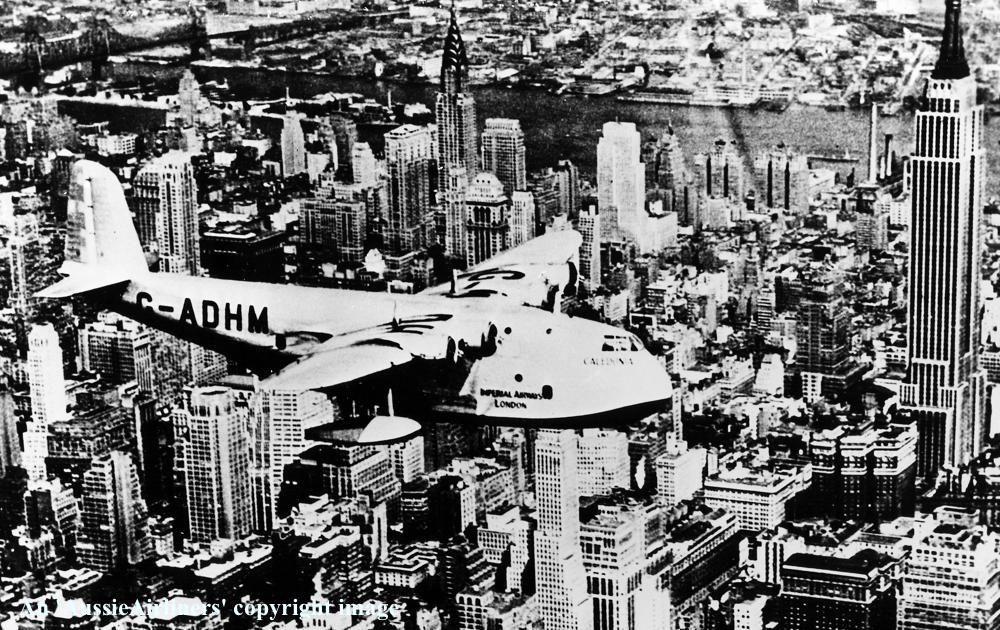G-ADHM. Short S.23 'C' Class Empire Flying Boat. c/n S.804. |
This aircraft was the second Empire boat to be completed and flown by Short Bros at Rochester, Kent The order was placed by Imperial Airways, London - January 24, 1935 The official written order shows the cost of the aircraft at UKP 37,800 - February 19, 1935 Converted to present day values this would be approximately UKP 3,417,876 Built as an S-23 Empire Class Mk.III flying boat having 920 h.p. Bristol Pegasus Xc poppet-valve radial engines It was the first long-range S.23 flying boat, and was often referred to as an 'Atlantic' flying boat It was fitted with the 'Type M1B' fuel system - consisting of two fuel tanks of 326, 2 tanks of 179 gallons and 2 tanks of 380 gallons each The fuel tanks were mounted in the wing, the 380 gallon tank was positioned between the fuselage and inner engine while the 326 gallon and the 179 gallon tanks were positioned beteen the inner and outer engine It also had 2 hull-mounted fuel tanks of 280 gallons each, for a total fuel capacity of 2,330 gallons This provided a flight duration of approximately 17 hours 40 minutes Its range in still air was 2,754 nm (5,110 km) or against a 35 kt headwind the range was 1,911 nm (3,545 km) It had an all-up weight of 50,500 lb, and could cruise at approximately 164 m.p.h. Entered onto the British Aircraft Register as G-ADHM (CofR 5882) - June 17, 1935 Registered to Imperial Airways Ltd, Victoria Station, London It was allocated a 'Fleet Number' (No. 2) which was used in all operational records to identify the aircraft Launched on the Medway River at Rochester without cabin fittings - September 11, 1936 The aircraft was named 'Caledonia' First flown at Rochester by the Short Brothers' Chief Test Pilot, John Lankester Parker - September 11, 1936 Test flown at Rochester with the aircraft loaded to its 'medium' weight - September 12, 1936 Test flown at Rochester with the aircraft loaded to its 'maximun permitted' weight - September 13, 1936 Following these successful test flights 'Caledonia' was positioned to the Marine Aircraft Experimental Establishment (MAEE) at Felixstowe to undertake a series of static tests and test flights / trials as this aircraft had been chosen to be the 'first of type' to be submitted for the issuing of the 'Certificate of Airworthiness' Certificate of Airworthiness (CofA No. 5683) awarded - September 30, 1936 For the next 8 - 9 weeks 'Caledonia' was heavily involved in fuel consumption tests and pilot training and as there was no urgency for the issuing of the CofA, it was not physically issued until - December 04, 1936 Delivered to Imperial Airways, London - December 04, 1936 Entered service with Imperial Airways flying Hythe - Alexandria as Flight AS406 - December 18, 1936 This 'proving flight' carried some 40 bags ( 5.5 tons) of Christmas mail destined for Africa Route: Hythe - Marseilles - Brindisi - Alexandria Departed Alexandria on the return flight to Hythe as Flight IW504 - December 21, 1936 The Alexandria - Marseilles leg (1,700 miles) was flown non-stop in 11 hrs 15 mins (Capt W. N. Cumming) The aircraft was carrying over half-a-ton of mail destined for England Departed Southampton as Flight EX1 Westward on the first survey flight across the North Atlatic Ocean - July 04, 1937 It arrived at Manhasset Island, Port Washington, New York - July 06, 1937 Route: Southampton - Foynes - Botwood - Montreal - New York Flight crew: Capt A. S. Wilcockson; F/O G. H. Bowes; W/O T. E. Hobbs; W/O T. Valette Departed New York as Flight EX1 Eastward on the return flight to England - July 12, 1937 It arrived at Hythe having completed the return flight - July 17, 1937 Operated trans-Atlantic crossing as Flight EX3 - August 13 - 21, 1937 Operated trans-Atlantic crossing as Flight EX5 - September 10 - 24, 1937 'Caledonia' operated the survey flight Hythe - Lisbon - Azores (Horta) - October 06 - 07, 1937 It arrived at Hythe having successfully carried out this 'survey' flight - October 11, 1937 Crew: Capt G. J. Powell; F/O C. F. Elder; W/Os H. Dangerfield and P. A. Woods Capt Powell advised that due to large open-sea swells at Horta, this route was not suitable for S.23 operations Following this survey flight 'Caledonia' was reconfigured to a standard S.23 Mk 1 specification Its extra fuel tanks were removed and installed on the Short S.23 boat G-ADUT 'Centaurus' This was done in preparation for the survey flight to Australia and New Zealand by G-ADUT 'Centaurus' 'Caledonia' then commenced normal operations with Imperial Airways Departed Hythe as Flight IE641X (extra flight) Singapore - April 03, 1938 This aircraft was part of the aircraft pool operated by Imperial Airways and Qantas Empire Airways on services between Southampton, England and Sydney, Australia Qantas Empire Airways crews flew the aircraft on the Sydney - Singapore - Sydney sector of this route between July 1938 and October 15, 1941 Following the outbreak of World War II, 'Caledonia' and all the other Empire Flying Boats were placed under the jurisdiction of 'National Air Communications' - August 31, 1939 Imperial Airways and the original British Airways were merged to form British Overseas Airways Corporation - April 01, 1940 'Caledonia' departed Poole enroute to Karachi - June 09, 1940 Following Italy's entry into World War II, air routes across the Mediterranean Sea were closed - June 10, 1940 This flight was then diverted, flying Ajaccio - Bizerta - Malta - Navarino - Athens - Alexandria - Tiberias - Habbaniyah - Basra - Dubai - Karachi The 'Allied Airways Joint Committee' replaced the 'National Air Communications' - June 27, 1940 Under these organisations, the 'Empire' flying boats could be commandeered at any time or place for sometimes very secret and rather dangerous operations, depending on the wartime requirement 'Caledonia' remained at Karachi awaiting further instruction until - July 02, 1940 Operated Karachi - Sydney - Singapore - Sydney - Durban as Flight WS12 It was then based in South Africa (Durban) to operated on the 'Horseshoe' route for the rest of World War II Ownership was officially transferred to British Overseas Airways Corporation - August 27, 1940 The original Pegasus XC engines were replaced with Pegasus XXII engines of 1,010 hp at Durban - ? 1940 It was also fitted with three additional 220 gallon fuel tanks at Durban - ? 1940 The take-off weight was increased to 52,500 lb It was operated on the 'Horseshoe Route' linking Durban to Sydney until Singapore fell to the advancing Japanese Army - February 15, 1942 The Eastern Terminus on the 'Horseshoe Route' was pulled back to Calcutta after Singapore was invaded It was involved in a rescue mission from Durban - October 13, 1942 It was tasked to locate the crew of the downed Catalina 1 - AH543 - attached to 209 Squadron, Pembroke Dock The Catalina had ditched in a storm some 52 miles N.E. of Lourenco, Marques, Mozambique The location and rescue of the crew was successful and it returned to Durban the same day 'Caledonia' operated its final commercial service Cairo - Durban as Flight 50E7 - March 03 - 07, 1947 It was the last Empire boat left in Africa and in B.O.A.C.'s fleet Departed Durban on the ferry flight to Poole (Capt P. Horne) - March 10, 1947 It arrived at Poole having completed its ferry flight - March 14, 1947 It was ferried Poole - Hythe - March 15, 1947 All useful equipment was then removed from the aircraft at Hythe It was then towed to Marchwood on Southampton Water - March 22, 1947 It was broken up at Marchwood by R. J. Coley and Sons, Ltd 'Caledonia' had flown a total of 15,143 hours Cancelled from the British Aircraft Register - April 21, 1947 |
 |
G-ADHM. Imperial Airways - 'Caledonia' in the all-metal livery at Rochester, Kent, October 1936. (R. N. Smith Collection Copyright Image 2545-376.) |
 |
G-ADHM. Imperial Airways - 'Caledonia' in the all-metal livery at Port Washington, New York, July 06, 1937. (W. Bleutenmueller Copyright Image 2545-957.) |
 |
G-ADHM. Imperial Airways - 'Caledonia' in the all-metal livery at Port Washington, New York, circa 1937. (P. Sheehan Collection Copyright Image 2545-881.) |
 |
G-ADHM. Imperial Airways - 'Caledonia' in the all-metal livery over New York City, circa 1937. (R. N. Smith Collection Copyright Image 2545-260.) |